Anthurium veitchii, commonly known as King Anthurium, is a species of the genus Anthurium that belongs to the Araceae family. The plant is native to northern South America and thrives in tropical regions with high humidity levels.
This striking tropical plant is known for its lush, velvety leaves that can grow up to 4 feet long and 1 foot wide. Its large waxy leaves have a distinct deep-green color with prominent white veins running through them.
The Anthurium veitchii species has two subspecies, namely: Anthurium Veitchii ‘Angustilobum’ and Anthurium Veitchii ‘Hookeri’. Both varieties of this plant are popular among indoor gardeners due to their unique appearance and relatively easy care requirements.
If you are looking for an exotic plant addition for your indoor garden or office space, this species will undoubtedly capture your attention. The King Anthurium is not only aesthetically pleasing but also has air-purifying properties that make it an excellent choice for improving air quality in any space.
The plants act as natural humidifiers by absorbing excess moisture from the atmosphere while simultaneously regulating temperature levels in the room. Additionally, these plants have been found to remove harmful toxins like formaldehyde from indoor air spaces.
Care Tips: To ensure optimal growth and health of your King Anthurium, avoid exposing it to direct sunlight as it can scorch its leaves. Instead, place it in bright indirect light for about six hours daily.
Another critical factor when caring for your King Anthurium is keeping the soil consistently moist but not waterlogged . You should also avoid using cold water when watering your plant as this can cause shock and damage its root system.
Make sure you fertilize your King Anthurium regularly using a balanced liquid fertilizer to promote healthy growth and keep its leaves vibrant and attractive. The Anthurium veitchii – King Anthurium is undoubtedly a must-have for any indoor plant enthusiast.
Its alluring appearance and air-purifying properties make it an excellent choice for anyone looking to add some tropical flair to their space while simultaneously improving air quality. With the proper care techniques, you can enjoy this captivating plant’s lush beauty for many years to come.
Genus Species

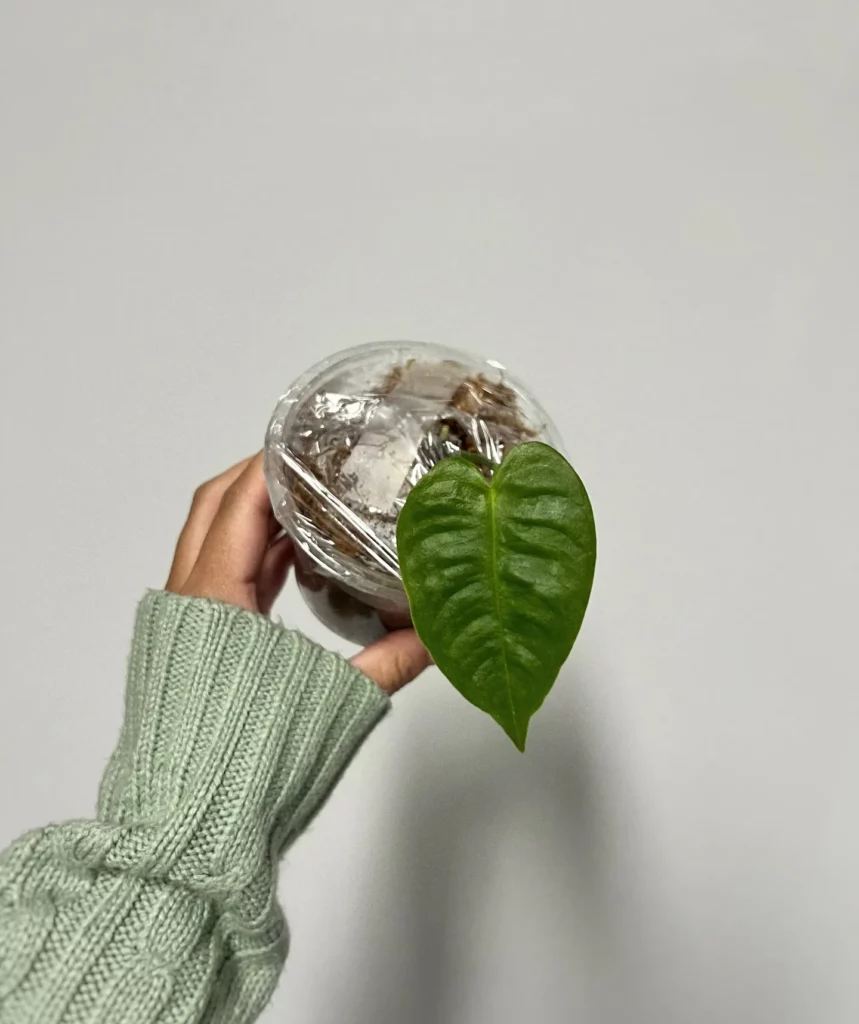
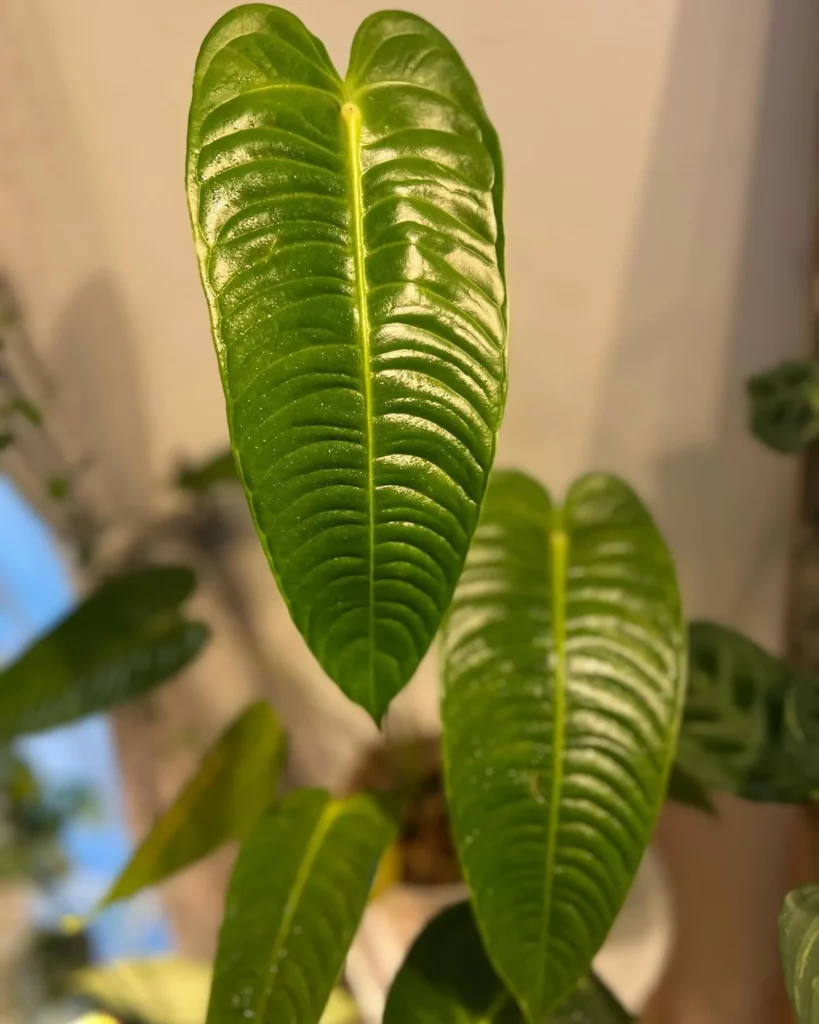
Anthurium veitchii – King Anthurium is a beautiful and exotic plant that belongs to the family of Araceae. It is considered one of the most striking plants in the Anthurium genus, and its unique foliage makes it stand out from other houseplants. The genus Anthurium includes more than a thousand species, each with its distinctive appearance and characteristics.
However, what sets Anthurium veitchii apart is its velvety leaves with prominent veins that resemble a king’s crown. When it comes to the species name, Anthurium veitchii was named after John Veitch, who was an avid plant collector in the 19th century.
He was known for his exploration trips to South America and Southeast Asia, where he discovered several rare plant species that are still popular today. The natural habitat of Anthurium veitchii is in the rainforests of South America, where it grows as an epiphyte on tree trunks or rocks.
This means that it doesn’t require soil to grow but rather attaches itself to another object for support while absorbing nutrients from its surroundings through its roots. As a result, these plants need excellent drainage systems when planted in soil.
No products found.
Care Tips: For enthusiasts looking to recreate this environment at home for their King Anthuriums should consider using organic potting mixes or a bark-based medium. Despite being a popular plant among horticulturalists and collectors alike worldwide, this rare beauty faces many environmental issues caused by deforestation in their natural habitats such as illegal collection or sale which affects wild populations greatly diminishing their numbers year after year.
So if you want your own King Anthurium for your home collection – please make sure you buy nursery-grown specimens only and avoid contributing to illicit activities that are putting these beautiful plants at risk. Knowing about genus species can add extra knowledge about any plant which can help immeasurably in taking proper care of it.
As a collector and caretaker, it is our responsibility to keep the plants safe from any kind of hedonistic activities and create an environment that is conducive to their growth and well-being. Care Tips: Before buying any plants, do research about their origin and legalities involved – only trust reputable sellers with ethical practices.
Anthurium veitchii – King Anthurium Appearance

Anthurium veitchii, also known as King Anthurium, is a beautiful plant that stands out because of its unique appearance. This stunning houseplant is native to Colombia and Ecuador and it belongs to the Araceae family. The plant has large, glossy dark green leaves with prominent veins that give it an almost prehistoric look.
The leaves can grow up to 3 feet long and 1 foot wide, making this plant an excellent statement piece in any room. The most striking feature of Anthurium veitchii is its magnificent velvety foliage.
The foliage is not just another shiny green leaf but has a texture that gives the whole plant a royal feel. This distinct feature makes the plant stand out among other plants in your collection.
Each leaf has a unique pattern, and the color varies from deep green to rich teal, depending on how much light it gets. Another great thing about Anthurium veitchii is that it’s relatively easy to care for – if you know what you’re doing!
With proper care, this stunning plant can thrive for years in your home or office space. Care tips for Anthurium veitchii include placing the plant in bright but indirect sunlight and keeping it away from drafts or extreme temperatures.
You should also make sure to keep the soil moist but not waterlogged and provide high humidity levels around the plant by misting regularly or using a humidifier nearby. Overwatering can cause root rot which harms your precious King Anthurium foliage turning brownish-black and wilting away.
If you want a low-maintenance yet strikingly gorgeous houseplant with eye-catching foliage, then look no further than Anthurium veitchii! Just follow these care tips closely so that your King Anthurium will be happy and healthy for years to come!
How To Grow Anthurium veitchii – King Anthurium
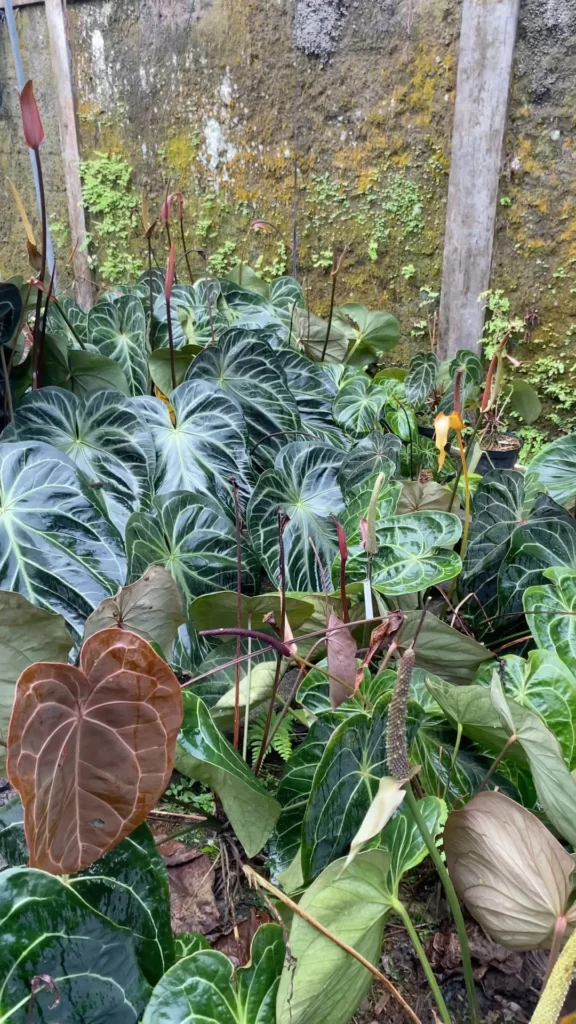
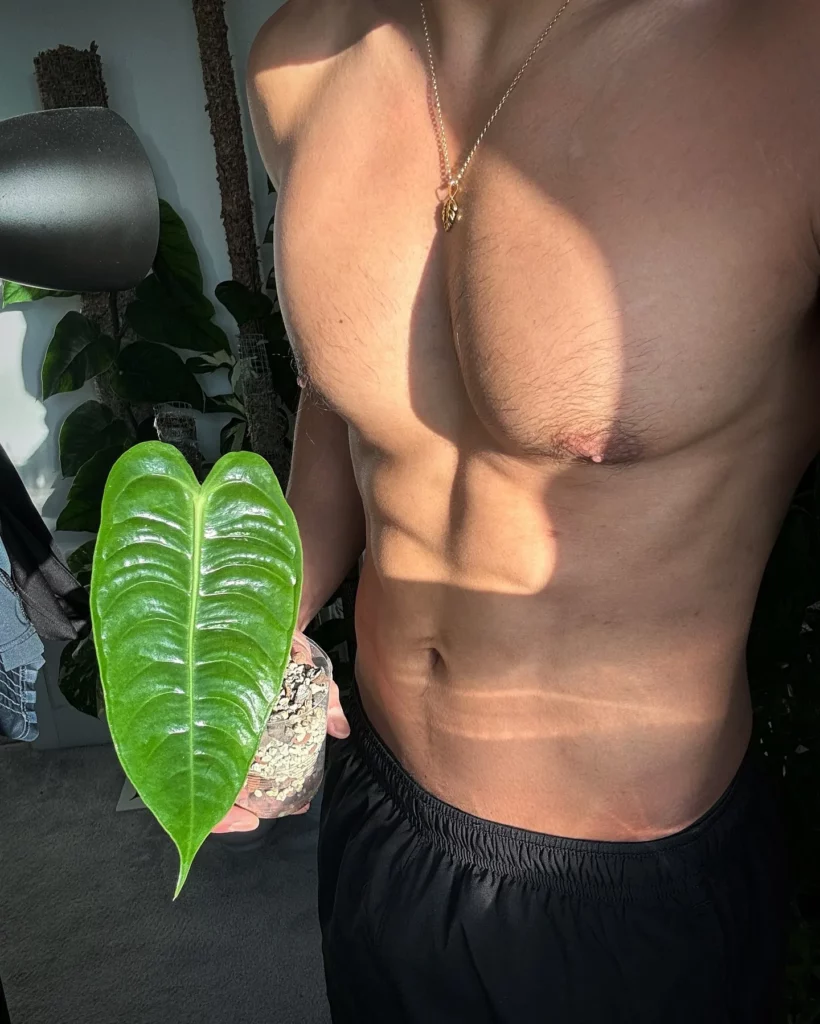

Growing Anthurium veitchii, also known as King Anthurium, can be a rewarding yet challenging experience for plant enthusiasts. This tropical beauty is native to the rainforests of South America and requires specific care to thrive in indoor settings.
Here are some tips on how to grow Anthurium veitchii and keep it healthy: First and foremost, it is essential to provide adequate light for your King Anthurium.
Although it can tolerate low light conditions, it will not produce new growth or flowers without sufficient light. So my advice is to place your Anthurium veitchii in a location with bright but indirect sunlight.
Next up on the list of growing tips is soil requirements. Anthurium veitchii prefers well-draining soil that stays moist but not waterlogged.
Therefore, make sure you choose a high-quality potting mix that contains peat moss, perlite, and vermiculite. These ingredients help maintain the right balance of moisture and nutrients for your plant’s root system Care Tips.
When it comes to watering your King Anthurium, my recommendation is to avoid overwatering at all costs. Waterlogging can quickly lead to root rot and other fungal diseases that may harm your plant’s health.
Instead, try watering once a week or when the top inch of soil feels dry. Always use room temperature water or filtered water since tap water may contain chlorine or fluoride that can be harmful Care Tips.
Fertilizing your Anthurium veitchii is another critical factor in its growth and development. Use a balanced liquid fertilizer every four weeks during the growing season (spring and summer) at half strength only since this plant doesn’t need much feeding even if people suggest otherwise Care Tips.
Growing Anthurium veitchii may require some effort and patience from you as an owner but believe me; it’s worth it! Follow these care tips, and your King Anthurium will be sure to thrive, becoming an eye-catching centerpiece in your indoor garden.
Anthurium veitchii – King Anthurium Propagation Tips

Propagation Tips for Anthurium veitchii – King Anthurium Are you tired of spending money on expensive plants?
Do you want to share the love of your Anthurium veitchii – King Anthurium with your friends and family? Well, propagation is the answer!
Here are some sure-fire tips to get started: Firstly, you need a healthy and mature plant to begin propagating.
Take a close look at your plant and select a stem that is sturdy but not too woody. You want it to bend slightly without breaking off.
Then clean your tools with rubbing alcohol or hot water and make a clean cut just below the node. Next, remove all the leaves except for one or two at the top of your cutting.
These will help your cutting grow by providing nutrients through photosynthesis. Be sure to remove any flowers as they will only steal energy from your new roots forming.
Now it’s time to choose your propagation method! You can either propagate using water or soil depending on what you have available or what works best for you.
If using water, fill up a glass vase with distilled water (tap water contains minerals that may harm plant growth). Place your cutting in the vase so that only the stem is submerged in water, not any leaves as this may cause them to rot.
If propagating with soil, use a well-draining potting mix filled with perlite or sand for better drainage. Make a hole in the soil about an inch deep using a pencil or similar tool and insert your cutting into it until it stands upright.
Care Tips: Propagation requires high humidity levels so cover any cuttings placed in pots with a clear plastic bag until new roots begin sprouting (usually within 2-4 weeks). Change out any stagnant water weekly if propagating in vases as bacteria or fungi may develop otherwise.
Be patient! Propagation takes time so don’t move your cutting around or disturb it in any way until you see new growth.
Anthurium veitchii – King Anthurium Quick Care Overview
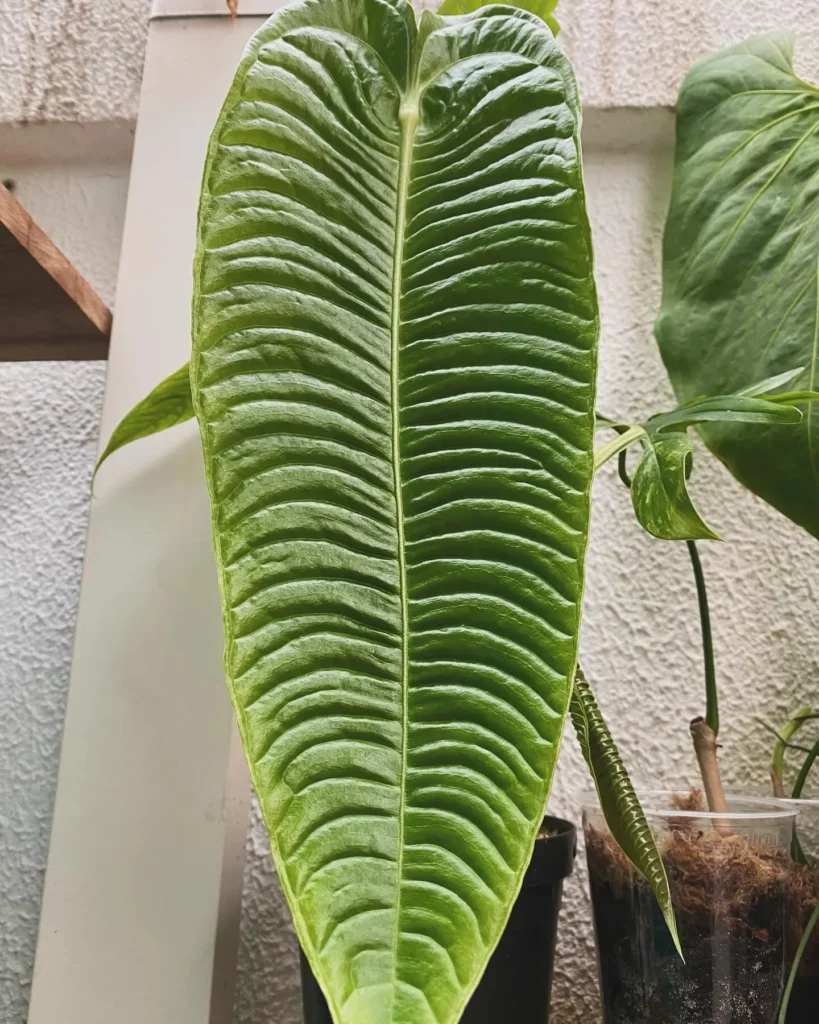
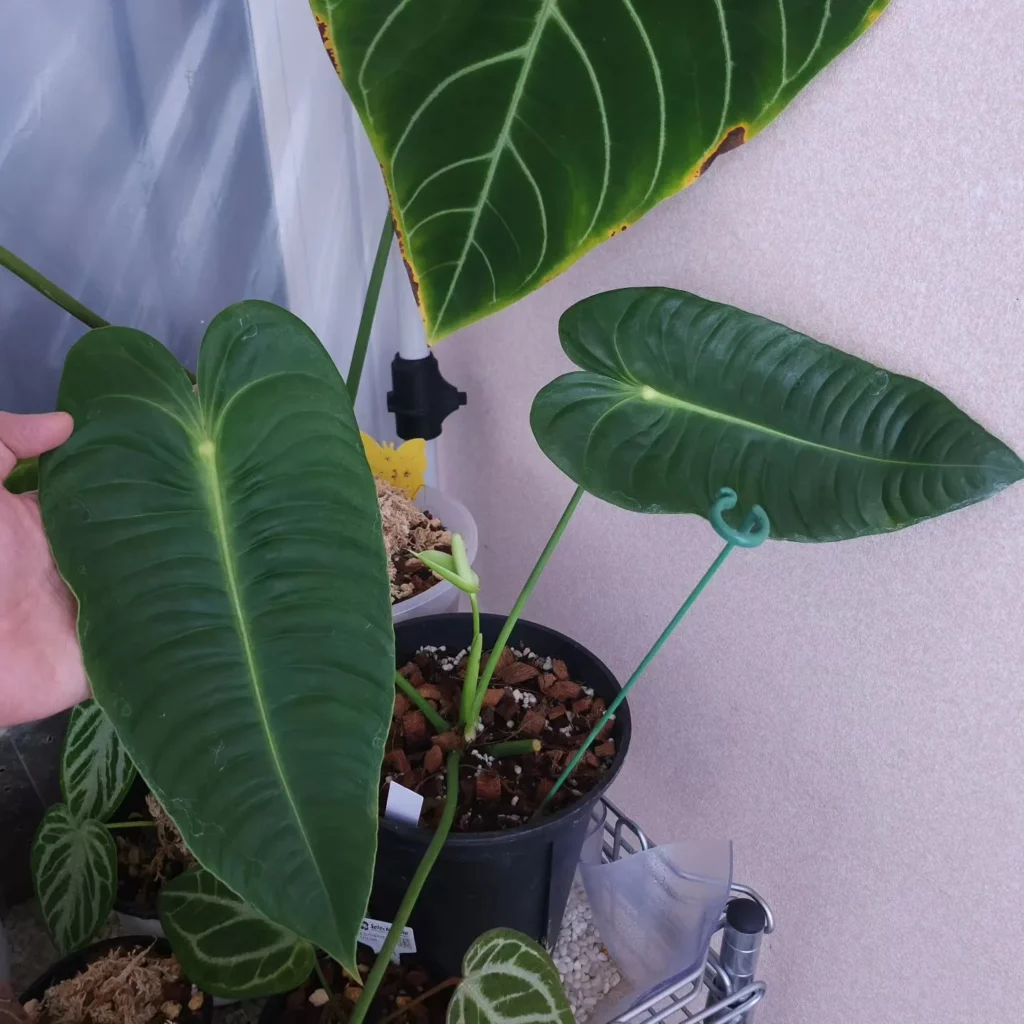
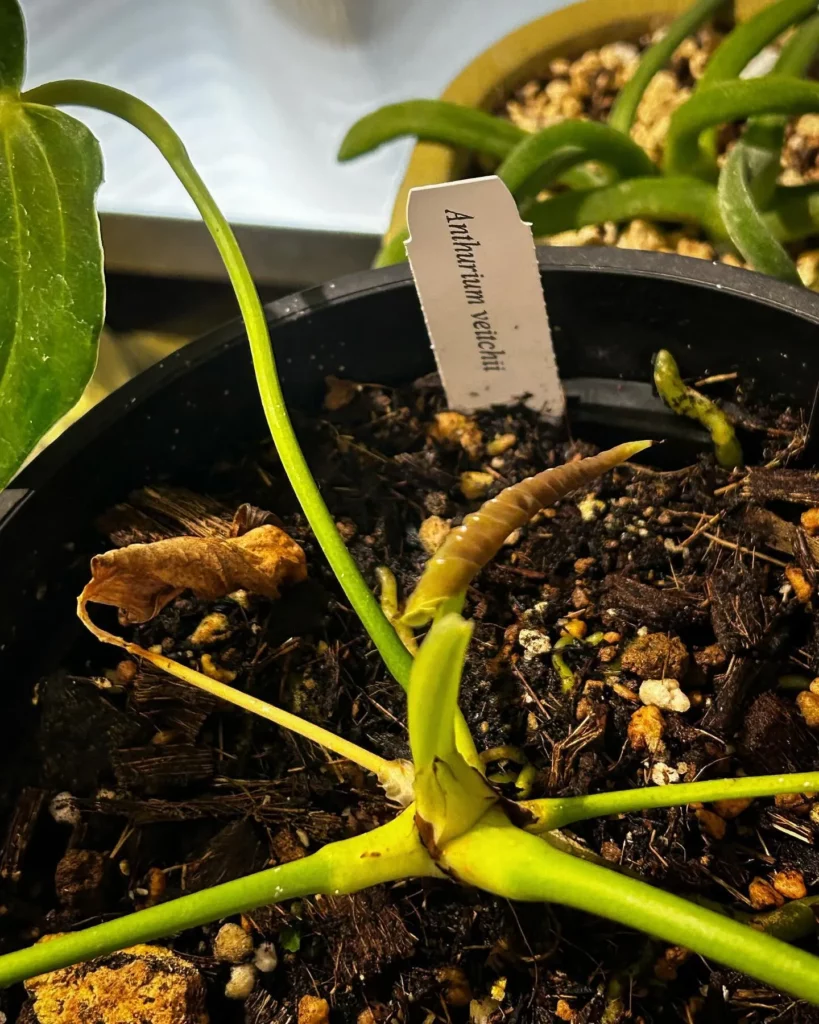
Anthurium veitchii, also known as King Anthurium, is a tropical plant that has been growing in popularity amongst houseplant enthusiasts. Its unique appearance and ease of care make it an ideal addition to any indoor garden.
In this section, we will go through the quick care overview of this fascinating plant and provide some care tips along the way. Firstly, let’s discuss watering.
One mistake people often make with Anthurium veitchii is overwatering. This can lead to root rot and ultimately death of the plant.
To prevent this, ensure that you only water when the top inch of soil has dried out completely. If you are unsure whether it’s time to water, stick your finger into the soil about an inch or so deep – if it feels dry, then go ahead and water.
Next up is fertilizing. Anthurium veitchii should be fertilized every two weeks during its growing season (spring and summer).
Use a balanced fertilizer with equal parts nitrogen, phosphorus, and potassium to promote healthy growth. During winter months or when the plant enters dormancy phase reduce frequency to once every 4-6 weeks.
One thing that sets Anthurium veitchii apart from other plants is its need for high humidity levels. These plants are native to tropical rainforests where humidity levels can reach up to 80%.
To keep your King Anthurium healthy indoors, you may need to use a humidifier specifically designed for plants or place a tray filled with pebbles and water beneath your pot. But not least important is lighting requirements for this species of Anthuriums .
They prefer bright but indirect light which means being placed in places away from direct sunlight which may scorch their leaves or too dark spots which may cause leaf yellowing or discoloration .A north-facing window usually provides ideal light conditions Care Tips : rotate your plant frequently so all the leaves will recieve equal amount of light and avoid light burn. Overall, Anthurium veitchii is a beautiful and easy-to-care-for plant that can bring some tropical vibes into your home.
Just remember to keep an eye on its watering, fertilizing, humidity, and lighting needs to ensure it stays healthy and happy. With these care tips in mind you’re now equipped with enough knowledge to grow a beautiful King Anthurium!
Anthurium veitchii – King Anthurium Light Requirements
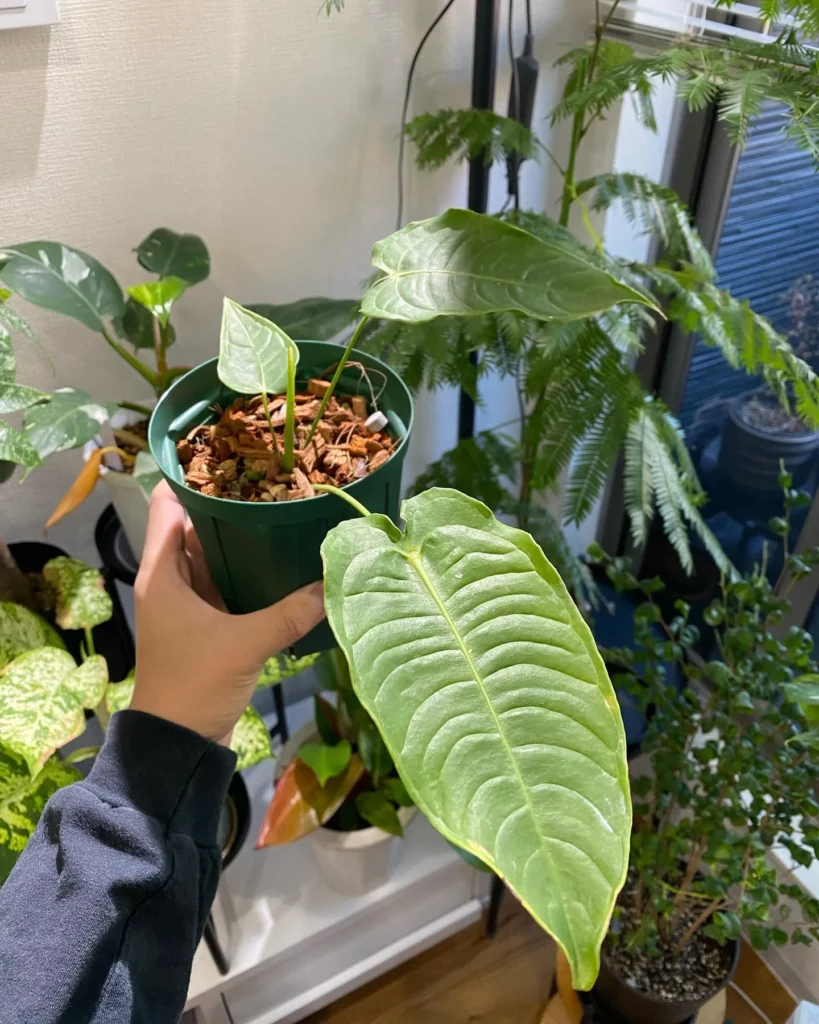
Anthurium veitchii is a beautiful, tropical plant that can be a real showstopper in any home, office or garden. However, in order to get the most out of your Anthurium veitchii, it’s important to understand its light requirements. This will ensure that your plant thrives and stays healthy for years to come.
Firstly, let me clarify that Anthurium Veitchii is not a low-light plant. It requires bright indirect light for optimal growth.
While some may argue that it can tolerate lower light conditions, I firmly believe that doing so will result in a weak and sad-looking plant. When selecting the location for your Anthurium veitchii, look for an area with bright but indirect sunlight.
East-facing windows are ideal as they provide morning sunlight which is less intense than afternoon sunrays. Alternatively, you can place your plant a few feet away from a bright window or beneath sheer curtains to filter the sunlight.
No products found.
One Care Tip I have found helpful is to rotate the pot regularly so all sides of the foliage receive equal amounts of light exposure. This helps prevent uneven growth and ensures your plant looks full and bushy.
The intensity of daylight varies depending on geographic location and time of year. If you live in an area with harsh summers or limited natural light come winter time Care Tips recommend using grow lights as supplementary lighting during dark periods.
While it may seem like taking care of an Anthurium veitchii requires a lot of work and attention to detail; providing proper lighting conditions is one easy way to ensure success. I implore all those who want their plants to thrive: please do not neglect this essential aspect of care!
Anthurium veitchii – King Anthurium Soil Requirements
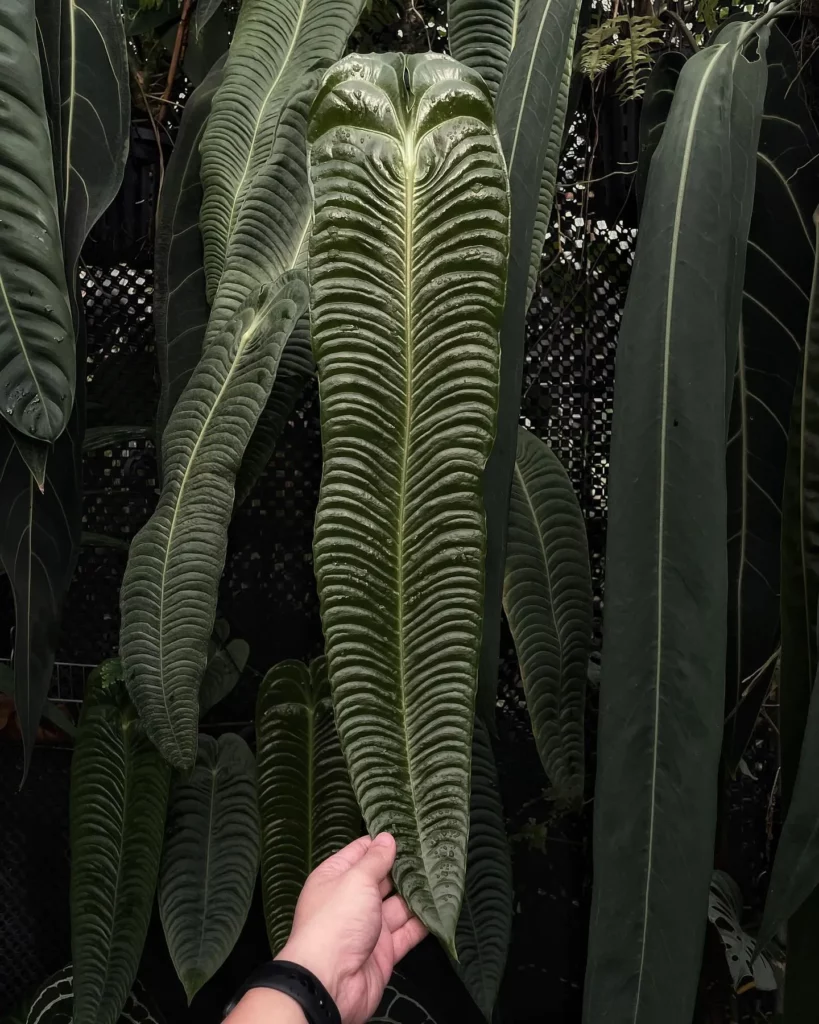
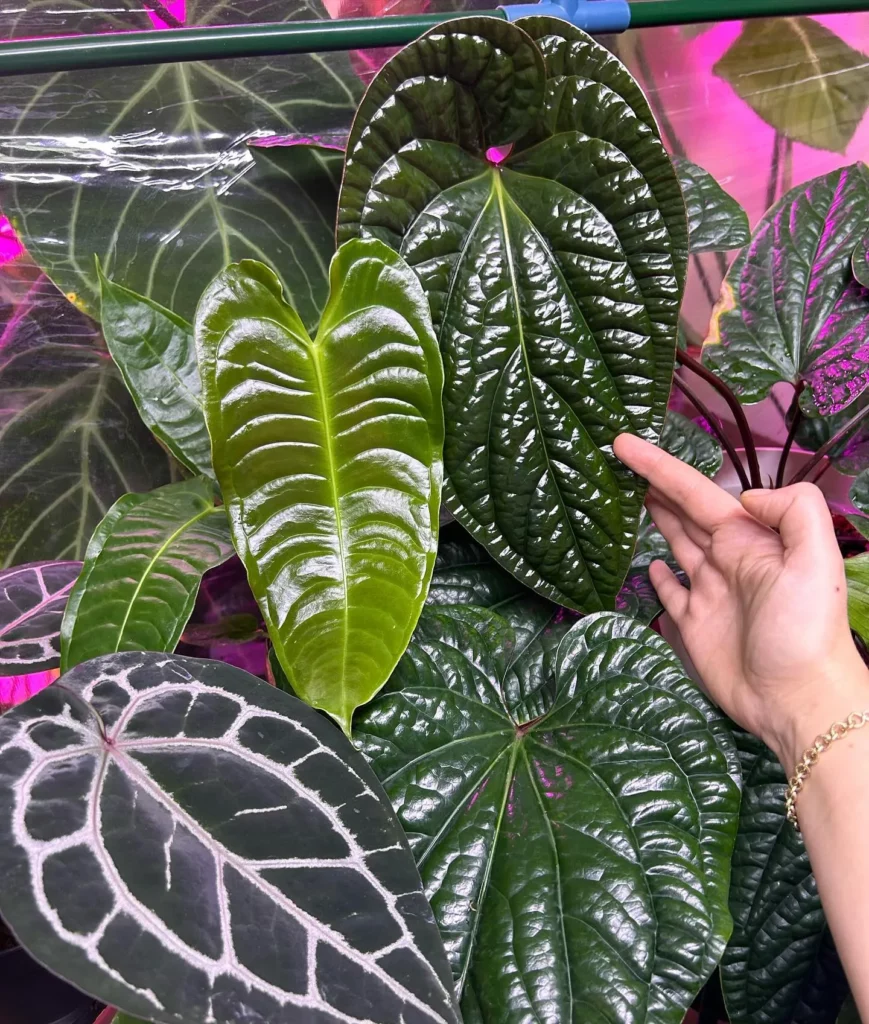
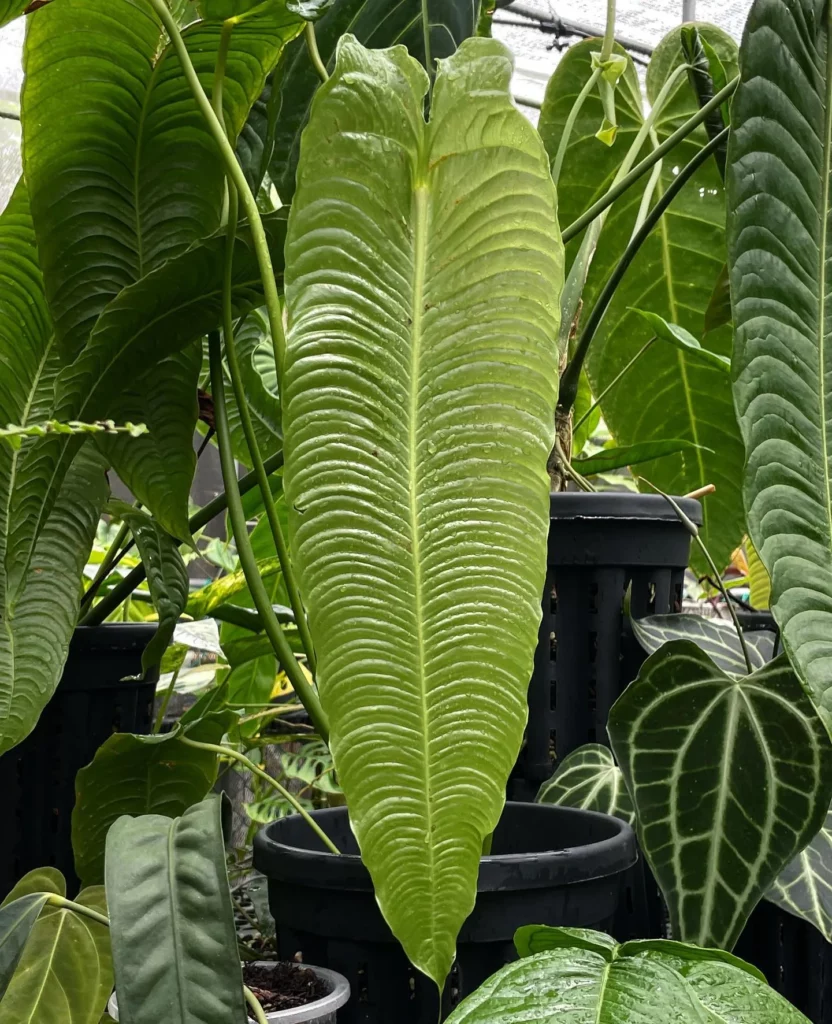
When it comes to Anthurium veitchii – King Anthurium care, soil requirements are one of the most important things to consider. This plant requires a well-draining potting mix that also has good water retention properties.
A high-quality soil mix will provide your King Anthurium with the right nutrients and moisture levels to thrive. Choosing the right soil for your Anthurium veitchii – King Anthurium can be a bit tricky, as the plant prefers a slightly acidic soil pH ranging from 5.5 to 6.5.
If you cannot find an acidic soil mix at your local garden center or nursery, try making your own by mixing peat moss with perlite or vermiculite. When potting or repotting your King Anthurium, make sure you choose a container that is only slightly larger than its current size.
The plant likes its roots to be snug in the container, which helps it maintain an appropriate level of moisture and nutrients. Care Tips: Be mindful not to overwater your King Anthurium when using a well-draining potting mix.
No products found.
While this type of soil allows for excess water to drain out easily, it can also dry out quickly if not watered regularly. Keep an eye on the moisture level of the soil and adjust watering frequency as necessary.
Another important thing to consider when choosing soil for your Anthurium veitchii – King Anthurium is its texture and structure. The ideal potting mix should be light and airy while still retaining enough moisture.
Choosing the right type of soil is essential for ensuring that your King Anthurium thrives in its new home. Be sure to select a well-draining potting mix with good water retention properties that provides adequate nutrients while also maintaining optimal pH levels for this tropical beauty!
Anthurium veitchii – King Anthurium Potting and Repotting
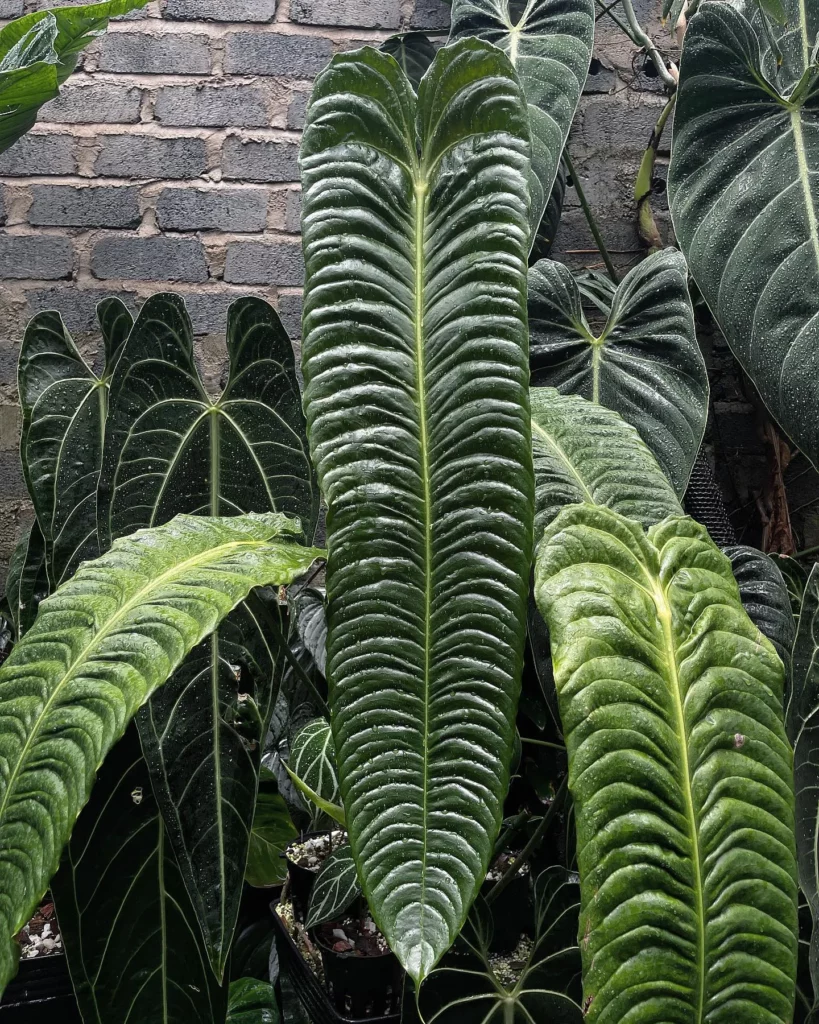
Potting and Repotting Anthurium veitchii – King Anthurium is a stunning plant with its broad, glossy green leaves and striking veins that run through them. Potting your King Anthurium in the right soil mix is crucial for its growth.
You want to ensure that the soil mix has good drainage as this plant does not like sitting in wet soil for long periods. A well-draining potting mix will help prevent root rot and fungus growth, which can be detrimental to your King Anthurium.
When it comes to pot size, you want to choose one that is slightly larger than the current pot. This allows for enough space for the roots to grow without overwhelming them with too much soil.
Repotting should be done every two years or so but only when necessary. Signs that your Anthurium veitchii needs repotting include roots growing out of the bottom of the pot or when you notice that the plant has stopped growing as it should.
Care Tips: Keep in mind that when repotting, you should also inspect your plant’s roots carefully. If there are any dead or rotting roots, they should be trimmed away before being repotted into fresh soil.
When it comes to repotting, gently remove your King Anthurium from its old pot and shake off any excess soil from its roots. Inspect the root system thoroughly and trim off any dead or dying roots using sharp scissors or pruning shears.
Be sure not to cut off too many healthy roots though as this can cause stress to your plant. Once you have trimmed away any dead roots, fill a new pot with well-draining potting mix up to about 1/3 of its depth before placing your Anthurium veitchii inside it.
Fill up the remaining space with fresh soil around the sides of your plant until it reaches about an inch below the rim of the pot. Care Tips: After repotting, be sure to water your plant thoroughly, and place it in a bright, warm spot away from direct sunlight for a few days until it adjusts to its new home.
Potting and repotting your Anthurium veitchii – King Anthurium is vital to its overall health and growth. By providing it with the right soil mix and pot size, you are setting up your plant for success.
Anthurium veitchii – King Anthurium Pruning and Shaping
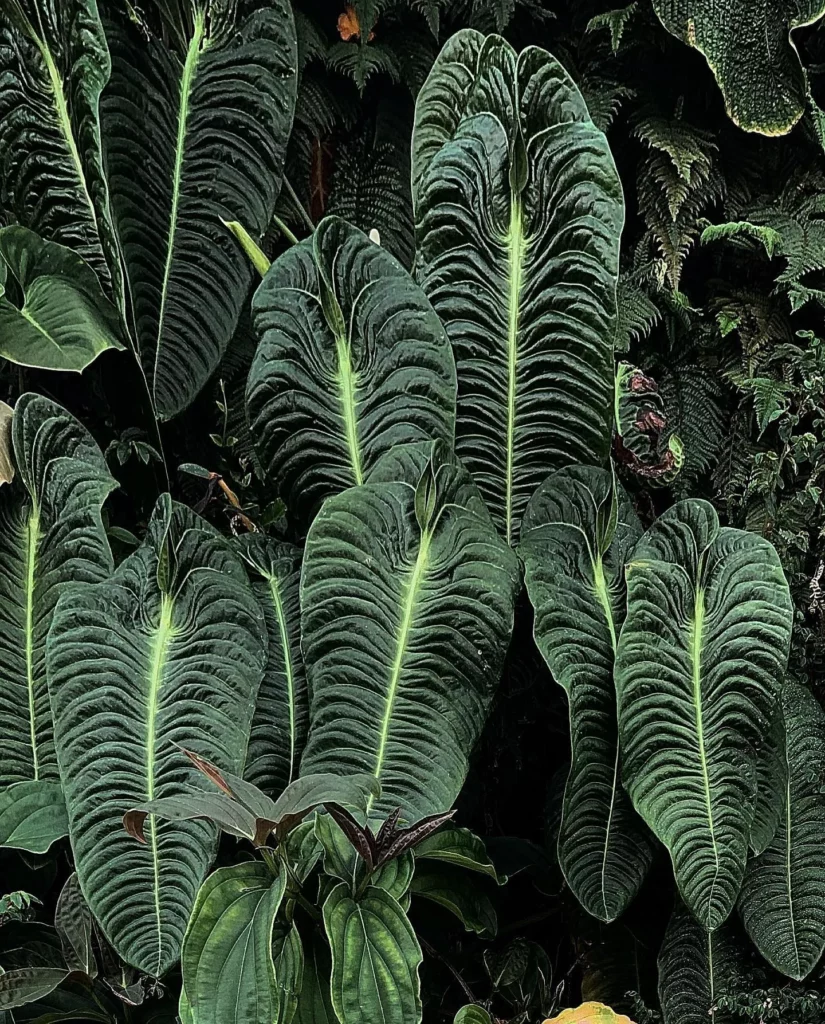

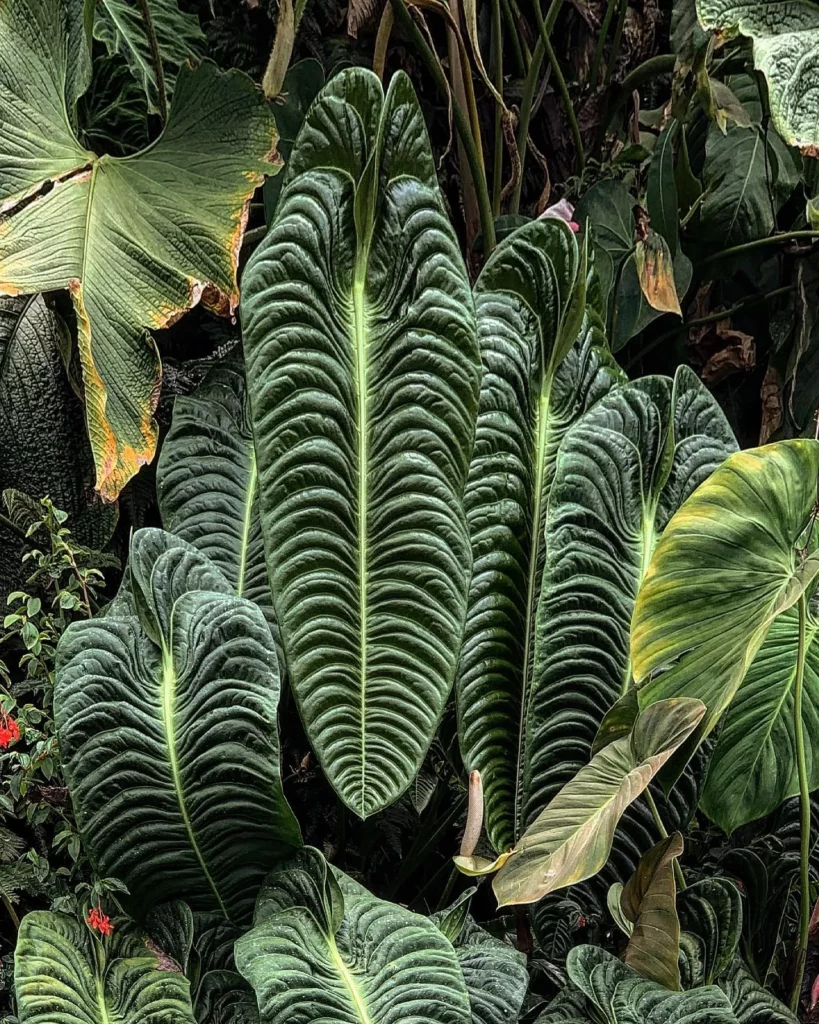
Pruning and shaping Anthurium veitchii – King Anthurium is essential to keeping this plant in good health and promoting its natural growth. This species of anthurium is known for its large, heart-shaped leaves that can grow up to three feet long. To keep the foliage looking fresh and vibrant, it’s important to prune away any damaged or diseased leaves regularly.
When pruning your Anthurium veitchii – King Anthurium, it’s important to use a clean, sharp pair of shears. This will help prevent damage to the remaining healthy foliage and minimize the risk of infection.
No products found.
Start by cutting away any yellow or brown leaves at the base of the plant. Keep in mind that while these leaves may look unsightly, they still play an important role in absorbing sunlight and helping the plant produce energy through photosynthesis.
In addition to removing damaged foliage, you can also shape your Anthurium veitchii – King Anthurium by selectively trimming back certain branches or stems. For example, if your plant is starting to look too tall or leggy, you can pinch back some of the taller stems near their tips.
This will encourage new growth lower down on the stem and help keep your plant looking fuller and more compact. Care Tips: When pruning your Anthurium veitchii – King Anthurium, be sure not to remove more than one-third of its total foliage at once.
This could shock the plant and slow its growth rate considerably. Instead, prune in small increments as needed over time.
While pruning is essential for keeping your Anthurium veitchii – King Anthurium looking healthy and vibrant, it’s also important not to overdo it. This species has a natural habit of growing tall rather than wide, so excessive pruning could actually harm the overall health of the plant by disrupting its natural growth pattern.
Anthurium veitchii – King Anthurium Temperature Requirements
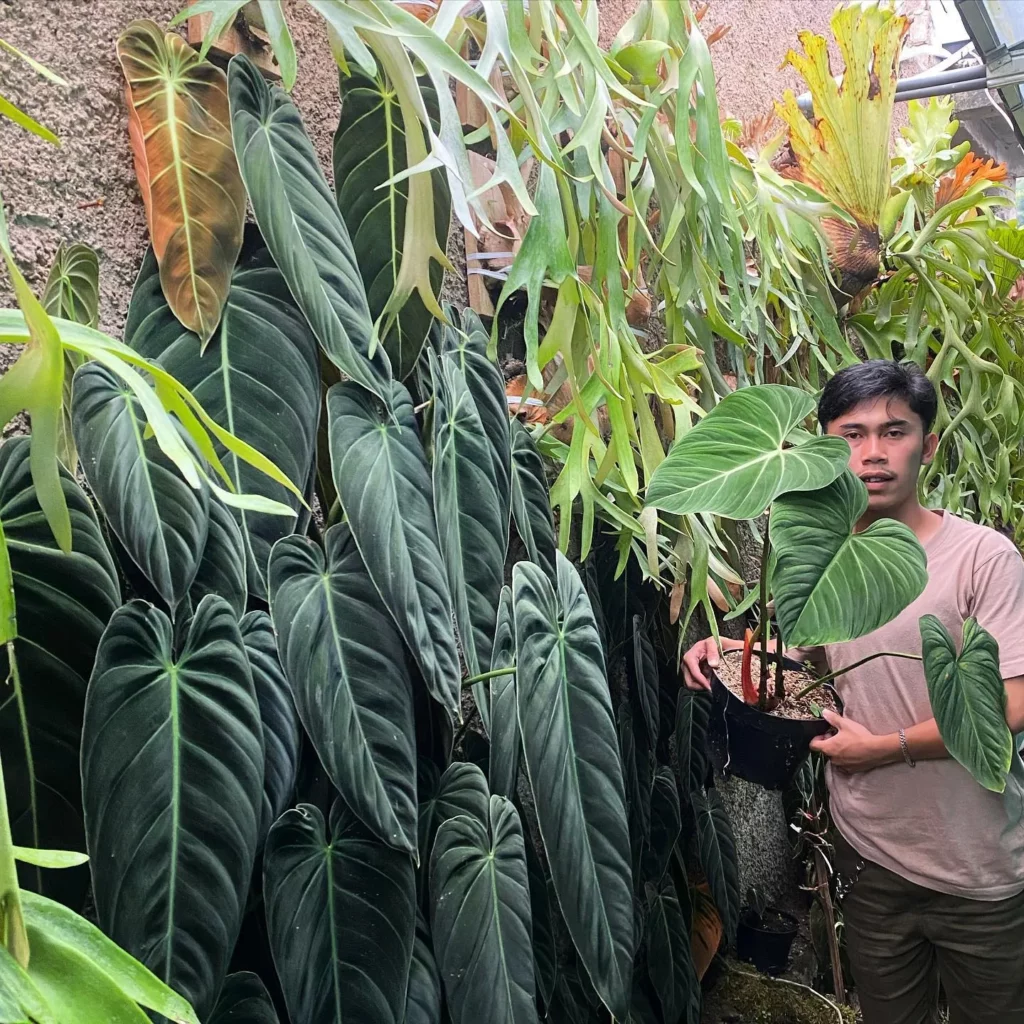
When it comes to taking care of your Anthurium veitchii, you must pay careful attention to the temperature requirements of this plant. These tropical plants thrive in warm, humid environments and are intolerant to cold temperatures.
Therefore, if you want to keep your King Anthurium healthy and beautiful, it is important to provide it with the ideal temperature conditions. First and foremost, it is crucial to avoid exposing your Anthurium veitchii to low temperatures.
These plants are sensitive to cold weather and can suffer from serious damage or even death when exposed to temperatures below 60°F (15°C). In general, the optimal temperature range for King Anthuriums is between 65-85°F (18-29°C).
No products found.
Anything below or above this range can cause stress on the plant. Another important factor in maintaining the ideal temperature for your Anthurium veitchii is avoiding sudden fluctuations in temperature.
It can be tempting to place your King Anthurium near a window during colder months or near an air conditioning unit during hot summers but doing so can cause harm. Sudden changes in temperature can shock the plant which may lead to stunted growth or yellowing leaves.
In addition to maintaining a consistent temperature range, providing proper humidity levels is equally important in ensuring optimal growth conditions for your King Anthurium. These plants require high humidity levels of around 60-80% Care Tips; however, they may tolerate lower humidity levels as long as they are kept moist.
If you live in a cooler climate and struggle with providing adequate warmth for your Anthurium veitchii, invest in a space heater or grow light that emits heat. This will ensure that your precious plant stays at its ideal growing conditions all year round.
Overall, it’s clear that paying attention to the temperature requirements of your Anthurium veitchii is essential for its survival and optimum growth potential. By following these simple tips, you can ensure that your King Anthurium thrives and brings joy to your home or office for years to come!
Humidity Requirements
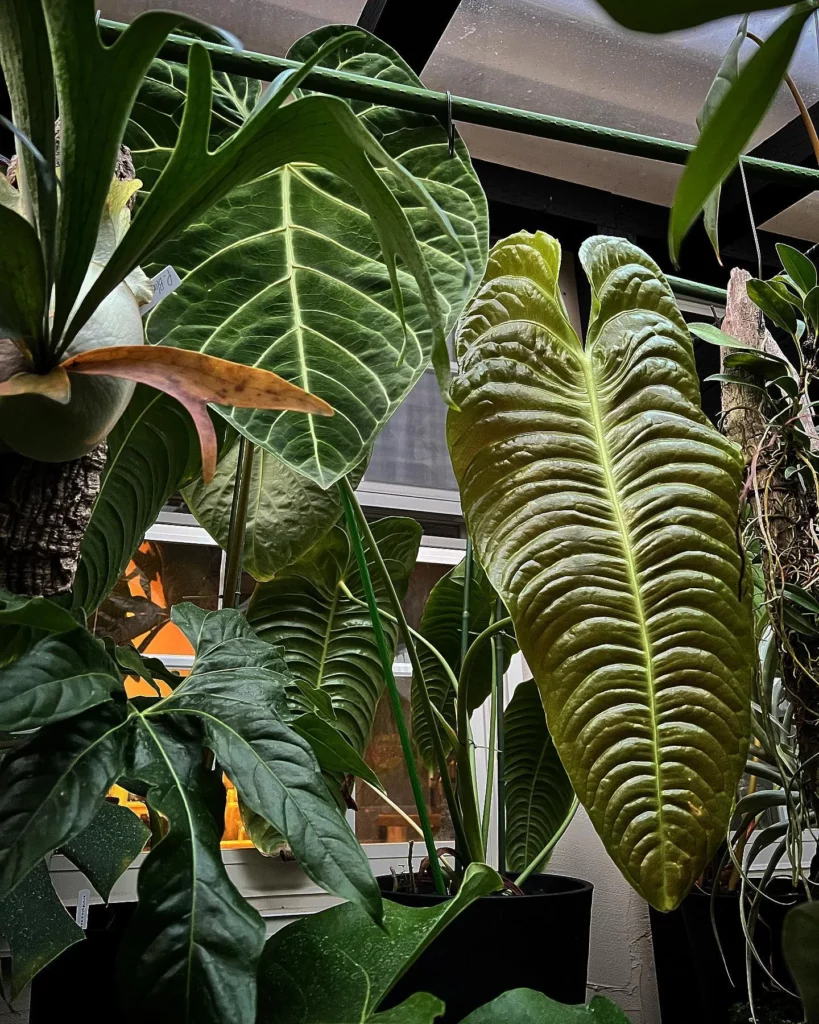

One of the most important factors in successfully caring for Anthurium veitchii, or any Anthurium plant for that matter, is humidity. These plants are native to tropical rainforests and they thrive in high humidity environments. If you live in a dry climate or have central heating or air conditioning running frequently, it can be a challenge to maintain the proper level of humidity for your Anthurium veitchii.
When it comes to Anthurium veitchii care tips, maintaining humidity levels between 70% and 80% is crucial for optimal growth and health. A lack of sufficient humidity can lead to wilting leaves, browning leaf tips, and stunted growth.
In order to ensure your plant gets the moisture it needs, consider investing in a humidifier or placing a tray filled with water near your plant. Another way to increase humidity around your Anthurium veitchii is by grouping it together with other plants that require similar conditions.
This can create a mini microclimate where the plants help each other retain moisture in the air. Additionally, misting your plant regularly can also help mimic its natural environment.
Now let’s talk about something controversial: using pebble trays as a way to increase humidity around your plant. While some people swear by them as an effective method for raising moisture levels, I personally don’t think they’re worth the effort.
Sure they may look pretty, but what’s the point if they don’t actually do much? Instead of relying on pebble trays which require constant refilling and maintenance, invest in a humidifier or try grouping your plants instead.
If you want to keep an Anthurium veitchii happy and healthy long-term then providing adequate humidity should be at the top of your care list. Don’t neglect this crucial aspect of care – invest in a humidifier or try some alternative methods like grouping with other plants or misting regularly.
And as for pebble trays? Personally, I say skip ’em and save yourself the hassle.
Watering Anthurium veitchii – King Anthurium
Water is essential for the survival of any plant, but too much or too little water can cause serious harm to your Anthurium veitchii.
When it comes to watering these delicate plants, you’ll need to strike a careful balance.
Care Tips: The first rule of watering your Anthurium veitchii is never to water on a schedule.
Always water your plant when the soil is dry up to two inches deep. If you stick to a rigid watering routine, you risk either over-watering or under-watering your King Anthurium, which can lead to root rot or dehydration respectively.
The thumb rule for watering anthurium veitchii is that the soil should be moist but never soggy. Overwatering can lead to root rot and stunted growth and if not addressed promptly can kill your plant.
Care Tips: To determine whether it’s time for watering, stick your finger into the soil up to two inches deep. If it’s still wet down there, hold off on watering until the soil dries out at that depth level.
However, if it’s dry below 2 inches deep in the soil layer then give the plant a good soak. The next thing that you need to consider when it comes with waters are temperature and quality.
Water which is too cold or hot can shock anthuriums and cause them stress. Aim for room temperature water whenever possible while using purified water instead of tap since they may contain high levels of chlorine and fluoride that may also harm anthuriums.
Care Tips: Another important point while watering Anthurium Veitchiis’ is always use a pot with drainage holes so that excess water will run off easily from roots else it might lead toxic salt build-up in roots overtime due stagnant moisture content in pots leading towards death.- Don’t let your beautiful King Anthurium wilt, shrivel, or turn yellow due to lack of watering. Careful attention to the moisture levels in your plant’s soil is crucial for its long-term health and vibrancy.
Fertilizing Anthurium veitchii – King Anthurium
If you want your Anthurium veitchii to grow and thrive, then you must fertilize it. Fertilizer provides essential nutrients that support the plant’s growth and development.
But, there’s also a catch. Too much of it can lead to problems such as root burn and even death.
For starters, I recommend using a balanced fertilizer with an N-P-K ratio of 10-10-10 for your Anthurium veitchii at least once every four months during the growing season. During winter or dormancy periods, reduce the frequency of application to once every six months since plants don’t require many nutrients during this time.
When applying fertilizer, make sure to moisten the potting mix before adding it since dry soil can cause fertilizer burn. After that, dilute your fertilizer in water as per the instructions on the package label since concentrated fertilizers can damage roots and kill your precious plant.
Now let’s talk about organic vs. synthetic fertilizers care tips for your Anthurium veitchii: If you’re environmentally conscious like me, use organic fertilizers instead of synthetic ones because they’re less harmful to the environment and more sustainable in the long run.
Some examples of organic fertilizers include compost tea, worm castings, guano tea, fish emulsion, among others. Organic care tips: Organic fertilizers contain naturally occurring micronutrients that promote healthy soil microbial activity while synthetic ones lack these elements.
In addition to that, organic fertilizers release their nutrients slowly over time as they break down which means less frequent applications are necessary compared to synthetic options.
Care tip: Avoid over-fertilizing your King Anthurium by following package instructions or recommendations from trusted sources since overfeeding them can lead to root burn or other issues such as pests infestations.
Care tip: Fertilizing your Anthurium veitchii is essential for its growth and well-being, but you must do it in moderation using the right type of fertilizer. Always follow care tips and recommendations from reliable sources to ensure that your King Anthurium stays healthy and happy for years to come.
Pest Control Tips for Anthurium veitchii – King Anthurium
When it comes to Anthurium veitchii – King Anthurium, keeping pests away is crucial for the plant’s health and longevity. These plants are susceptible to pest infestations just like any other indoor plant, and it’s essential to take preventive measures from the beginning. Here are some pest control tips that can ensure your Anthurium veitchii – King Anthurium stays pest-free.
Firstly, it’s essential to inspect the plant regularly for any signs of pests. Aphids, spider mites, mealybugs, and scale insects are the most common pests that attack Anthurium veitchii – King Anthurium plants.
Look closely at the undersides of leaves and stems for webbing or tiny insects. If you spot any such symptoms, don’t wait; take action immediately.
To control pests on your Anthurium veitchii – King Anthurium effectively, you can use natural remedies such as spraying with water or insecticidal soap. Washing the plant with a strong jet of water will remove small insects like spider mites or aphids from the foliage.
Insecticidal soap is a natural remedy that is effective in controlling soft-bodied insects like mealybugs and scale insects. Care Tips: Be cautious while using insecticidal soap because if used excessively or incorrectly can damage flowers or foliage on your plant.
If natural remedies aren’t working and you still find an infestation present on your plant despite efforts made to eliminate them through other means, then it may be time for harsher treatments such as chemical pesticides. Always read labels carefully before using chemical pesticides, as they can be harmful both to humans and pets if not used correctly.
Prevention is better than cure when it comes to preventing pest infestations on your indoor plants like Anthurium veitchii – King Anthurium Care Tips: clean your houseplants regularly by wiping their leaves with a damp cloth, Avoid over-fertilizing plants, which can attract pests. Quarantine any new plants before adding them to your collection, as they may carry pests that could spread to your other houseplants.
Anthurium veitchii – King Anthurium Common Problems
As with any plant, there are bound to be some issues that arise when caring for an Anthurium veitchii – King Anthurium. Here are some common problems you may encounter and how to deal with them:
Yellow Leaves: If your Anthurium veitchii – King Anthurium’s leaves are turning yellow, it is likely due to overwatering or poor drainage. The best way to fix this is to repot the plant in fresh soil and make sure the pot has adequate drainage holes.
Care Tips: Allow the soil to dry out slightly before watering again. Pest Infestations: Unfortunately, pests such as spider mites and mealybugs can sometimes find their way onto your Anthurium veitchii – King Anthurium.
To get rid of these pests, first isolate the plant from other plants to prevent infestation spread. Then wash off any visible pests with a damp cloth and treat the plant with neem oil or insecticidal soap according to instructions on the bottle.
No products found.
Care Tips: Regularly check your plants for signs of pest activity. Brown Spots on Leaves: Brown spots on leaves could indicate a fungal disease known as leaf spot which is usually caused by overwatering or high humidity levels.
To combat this problem, cut out any affected leaves and avoid getting water on foliage when watering.
Care Tips: Ensure that air circulation around your plant is good.
Root Rot: Overwatering can cause root rot in your Anthurium veitchii – King Anthurium which can lead to drooping stems, yellowing leaves and even death of the whole plant if nothing is done about it quickly enough! If you suspect root rot in your plant, remove it from its pot carefully being careful not hurt any roots then look at them one by one so as not miss anything significant then cut off any rotted or brown roots.
Then repot the plant in fresh soil with good drainage, and avoid watering until the soil has dried out a bit. Care Tips: Don’t let your plant sit in standing water for too long, and don’t water too frequently.
Frequently Asked Questions
Anthurium veitchii should be watered when the top inch of soil feels dry. It is recommended to water thoroughly and allow excess water to drain to prevent waterlogging.
Anthurium veitchii thrives in bright, indirect light and prefers temperatures between 65-80°F (18-27°C). It requires high humidity levels, ideally around 60-80%, and benefits from good air circulation.
No, Anthurium veitchii does not climb naturally. It is an epiphytic plant that typically grows as a compact, upright plant with large, leathery leaves.
A well-draining potting mix is suitable for Anthurium veitchii, such as a blend of orchid bark, sphagnum moss, and perlite. It is important to provide a mix that retains moisture without becoming waterlogged to promote healthy root growth.
After reading this, check out our other articles on:
Conclusion
Growing Anthurium veitchii – King Anthurium can be a rewarding experience for plant enthusiasts who are dedicated to cultivating and caring for their plants. While it may not be suitable for novice growers, the rewards of successfully growing and propagating this beautiful plant are well worth the effort.
To recap, Anthurium veitchii – King Anthurium is a striking plant with large, dark green leaves and white veins that contrast beautifully against its velvety texture. It requires bright but indirect light, high humidity levels, and well-draining soil with proper fertilization.
Though it may need some extra care to thrive, it’s a hardy plant that can adapt to various conditions. If you’re considering adding an Anthurium veitchii – King Anthurium to your collection or already have one but are struggling to keep it healthy, here are some care tips to help you get started:
Make sure the potting mix is moist but not waterlogged; water the plant only when the top inch of soil has dried out. Provide ample humidity by misting the leaves regularly or placing a humidifier nearby.
Fertilize with a balanced fertilizer every 4-6 weeks during growing season. Prune any dead or yellowing foliage regularly to keep the plant healthy and attractive.
By following these care tips, you can create optimal conditions for your Anthurium veitchii – King Anthurium to thrive. Remember that each plant is unique in its needs and preferences, so don’t be afraid to experiment with different techniques until you find what works best for your individual specimen.
Growing plants can be a fulfilling activity that connects us with nature while beautifying our living spaces. I hope this guide has inspired you to learn more about cultivating this stunning variety of anthuriums!









